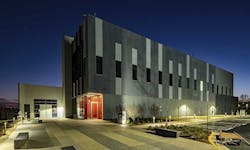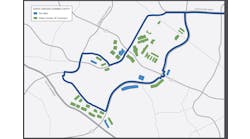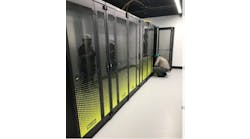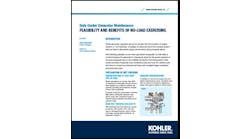Equinix Expands in Ashburn, Plans Fleet of Four-Story Data Centers
Ashburn, Virginia is where it all started for Equinix. More than 20 years after its very first data center helped create “Data Center Alley,” Equinix is kicking off its next phase of growth in Ashburn with a new campus, which will soon feature a fleet of four-story data centers.
Today Equinix opened the doors on DC21, the first building on a property just down the road from the original Equinix campus that anchors the world’s busiest Internet intersection. The $95 million first phase will feature 41,000 square feet of colocation space, along with a Co-Innovation Facility (CIF) where Equinix will work with customers to develop new approaches to data center power and cooling.
“The Ashburn market is continuing to grow by leaps and bounds,” said Jon Lin, the President, Americas for Equinix. “It has become the hub for all digital infrastructure. It’s the ideal location to tap into innovation and roll out new features.”
Although DC21 is just two stories, future buildings on the new campus will be four stories tall to boost the volume of racks and servers that Equinix can host in the buildings, according to Lin.
“Our planning sees us going more vertical,” said Lin, who said future Equinix buildings in Ashburn will use a four-story design it developed for its DA11 data center at the Dallas Infomart.
Equinix is the first company to announce plans for a four-story data center in Loudoun County, where most developers are building two-story projects, and the tallest data center is a three-story facility opened by QTS Data Centers in 2018.
$200 Million in 2020 Investment in Ashburn
Northern Virginia is home to more than 100 data centers and more than 10 million square feet of data center space. As the cloud grows, having servers in the region has become the table stakes for companies with ambitions in cloud computing. The area is unique in its connectivity, and that’s largely due to the success of Equinix, which specializes in making the physical connections that enable traffic to flow between networks and across the Internet.
Equinix built its very first data center in Ashburn in 1999, bringing together a critical mass of carriers and Internet on-ramps. The company has grown into a data center colossus, leasing space to 9,500 customers in 225 data centers across 63 cities around the world.
That now includes 16 data centers in Northern Virginia, housing more than 200 networks and providing on-ramps to major cloud platforms. DC21 is the first building on its new campus at the intersection of Loudoun County Parkway and Waxpool Road. Equinix bought the 34.5-acre site in 2017 for $1 million an acre, a deal that kicked off a sharp rise in land values in Data Center Alley.
Equinix says it can deploy 925 cabinets of customer equipment in the first phase. When the building is complete, it will provide total capacity of 3,100 cabinet equivalents and colocation space of more than 124,000 square feet. DC21 arrives barely six months after the opening of the $111 million first phase of Equinix DC15, boosting the company’s 2020 investment in Ashburn to more than $200 million.
Testing Innovations in Data Center Design
Equinix says the Ashburn expansion provides additional capacity to meet demand from the enterprise, government, cloud and financial services sectors. As these customers adopt new technologies, DC21 will serve as a testbed for how data center design will evolve.
Equinix has always worked with IT vendors to help test how new equipment will operate in a multi-tenant environment. Much of that research has focused on IT equipment like servers and switches.
“The new wrinkle is our ability to test solutions for the data center itself, like liquid cooling designs, containment and extreme density solutions,” said Lin, who noted that new deployments of hardware optimized for AI is creating demand for “spot cooling” to manage high-density zones within a multi-tenant environment. To add more flexibility to its cooling infrastructure, Lin said Equinix has recently switched from using indirect evaporative cooling to a design using chilled water.
Another area where the Co-Innovation Facility may be useful is in testing new approaches to the power chain. Lin said that the data center industry is considering the impact of new approaches to power infrastructure in the wake of Microsoft’s announcement that it plans to phase out diesel generators by 2030.
Ashburn is also one of four markets offering Equinix Metal, which aims to bring cloud-style automation to physical infrastructure, enabling dedicated servers to be provisioned “as a service.” It builds upon the bare metal server offering from Packet, which Equinix acquired earlier this year, and comes integrated with virtual networking technology to quickly connect users with essential clouds and services.
Taller Data Centers Are the Future
Equinix has not disclosed a specific timeline for when it will begin building four-story buildings in Ashburn, but Lin said that will be its standard design for the new campus, which has enough land to support at least three more data center buildings.
The move to taller buildings is a trend we first noted in 2017, as leading developers turned to vertical data center designs to boost their capacity to house IT gear. It’s a new direction for data center construction, which for many years focused on sturdy, single-story cement fortresses.
That was true for many years in Loudoun County, but as land for data center development becomes scarce, more projects are adopting multi-story designs that seek to make the most of real estate.
The four-story design is included in site plans filed with planning officials in Loudoun County, which has encouraged the use of multi-story data centers to support smarter growth for the sector. County revenue from taxes on computer equipment inside buildings in Data Center Alley will account for $395 million in the current fiscal year, helping cushion the county from the bruising impact of tax shortfalls related to the COVID-19 pandemic.






